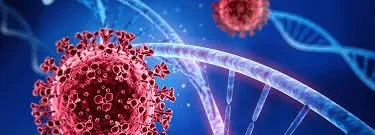Understanding COVID-19: Causes, Symptoms, Diagnosis, and Treatment
COVID-19, caused by the SARS-CoV-2 virus, has had an impact on global health, economies, and daily life. Since it was first identified in late 2019, the virus has spread rapidly, leading to a global pandemic. This blog post provides an overview of COVID-19, including what it is, its symptoms, diagnosis, causes, pathology, treatments, and the current state of the pandemic.
What is COVID-19?
COVID-19 is an infectious disease caused by the coronavirus SARS-CoV-2. The virus primarily spreads through respiratory droplets when an infected person coughs, sneezes, talks, or breathes. It can also spread by touching surfaces contaminated with the virus and then touching the face, although this is less common. COVID-19 can range from mild respiratory symptoms to severe, life-threatening illness.
Symptoms of COVID-19
COVID-19 symptoms can vary widely, and some people may be asymptomatic, meaning they do not exhibit any symptoms despite being infected. Common symptoms include:
Fever or chills
Cough
Shortness of breath or difficulty breathing
Fatigue
Muscle or body aches
Headache
New loss of taste or smell
Sore throat
Congestion or runny nose
Nausea or vomiting
Diarrhea
In severe cases, COVID-19 can lead to pneumonia, acute respiratory distress syndrome (ARDS), multi-organ failure, and death.
Diagnosis of COVID-19
Diagnosing COVID-19 typically involves testing for the presence of the SARS-CoV-2 virus. The most common diagnostic methods include:
PCR Test (Polymerase Chain Reaction): The gold standard for diagnosing COVID-19, PCR tests detect the genetic material of the virus. Samples are usually taken from the nose or throat using a swab.
Antigen Test: Rapid tests that detect specific proteins from the virus. While faster than PCR tests, antigen tests are generally less sensitive.
Antibody Test: Blood tests that check for antibodies produced in response to the virus. These tests indicate past infection rather than current infection and are not used for initial diagnosis.
Causes of COVID-19
COVID-19 is caused by the SARS-CoV-2 virus, which is part of the coronavirus family. These viruses are known for causing illnesses ranging from the common cold to more severe diseases like SARS (Severe Acute Respiratory Syndrome) and MERS (Middle East Respiratory Syndrome).
The virus spreads mainly through close contact with infected individuals. It can also be transmitted through airborne particles, especially in enclosed or poorly ventilated spaces. The high transmissibility of the virus has been a major factor in the rapid spread of the disease worldwide.
Pathology of COVID-19
COVID-19 primarily affects the respiratory system, but it can also impact other organs, leading to a wide range of symptoms and complications.
Respiratory System: The virus enters the body through the respiratory tract and binds to ACE2 receptors on the surface of cells, particularly in the lungs. This can lead to inflammation, fluid accumulation, and pneumonia. In severe cases, patients may develop ARDS, which requires mechanical ventilation.
Cardiovascular System: COVID-19 can cause damage to the heart muscle, increase the risk of blood clots, and aggrevate pre-existing heart conditions.
Neurological Effects: Some patients experience neurological symptoms such as confusion, seizures, and loss of taste or smell. The virus can also cause inflammation in the brain and nerves.
Kidney and Liver Damage: Severe cases of COVID-19 can lead to kidney and liver dysfunction, sometimes resulting in the need for dialysis or other interventions.
Immune Response: The body’s immune response to the virus can sometimes be excessive, leading to a “cytokine storm,” where the immune system attacks the body’s own tissues, causing widespread inflammation and damage.
Treatments for COVID-19
Treatment for COVID-19 varies based on the severity of the illness. While many people recover with minimal medical intervention, others may require more intensive care.
Mild Cases:
Rest: Most mild cases can be managed at home with rest, plenty of fluids, and over-the-counter medications to relieve symptoms like fever and body aches.
Isolation: It’s essential to self-isolate to prevent spreading the virus to others.
Moderate to Severe Cases:
Hospitalization: Patients with moderate to severe symptoms, particularly those experiencing breathing difficulties, may need to be hospitalized.
Oxygen Therapy: Supplemental oxygen may be required for patients with low oxygen levels.
Antiviral Medications: Drugs like remdesivir have been used to reduce the severity and duration of symptoms.
Corticosteroids: Medications like dexamethasone can help reduce inflammation and are often used in severe cases.
Monoclonal Antibodies: These laboratory-made proteins can help the immune system recognize and fight the virus. They are typically used in high-risk patients early in the course of the disease.
Mechanical Ventilation: In severe cases where the patient cannot breathe adequately on their own, mechanical ventilation may be necessary.
Long COVID:
Some individuals experience lingering symptoms for weeks or months after the initial infection, a condition known as "long COVID" or post-acute sequelae of SARS-CoV-2 infection (PASC). Management of long COVID involves multidisciplinary care tailored to the patient’s specific symptoms.
Conclusion
COVID-19 has reshaped the world in unprecedented ways, affecting millions of lives globally. While we have made significant improvements in understanding the virus, its pathology, and how to treat it, the pandemic is not yet over. Vaccination remains a crucial tool in preventing severe illness and controlling the spread of the virus. It is essential to stay informed, follow public health guidelines, and take appropriate measures to protect yourself and others.
As research continues and new treatments and vaccines are developed, our understanding and management of COVID-19 will continue to evolve. If you experience symptoms of COVID-19 or have been exposed to someone with the virus, seek medical advice and follow the recommended precautions to keep yourself and your community safe.

